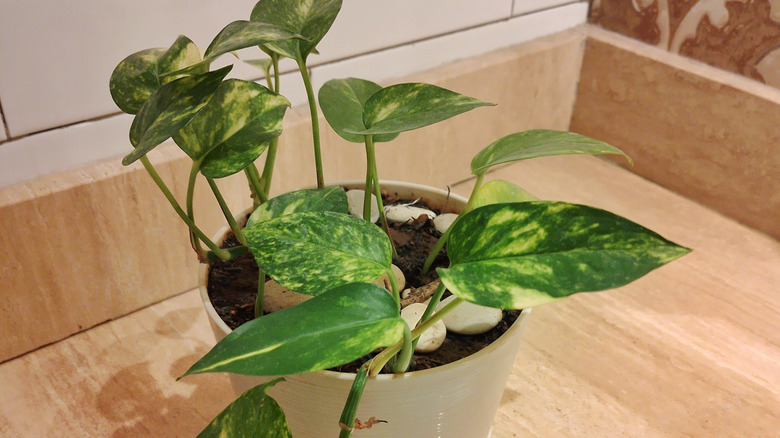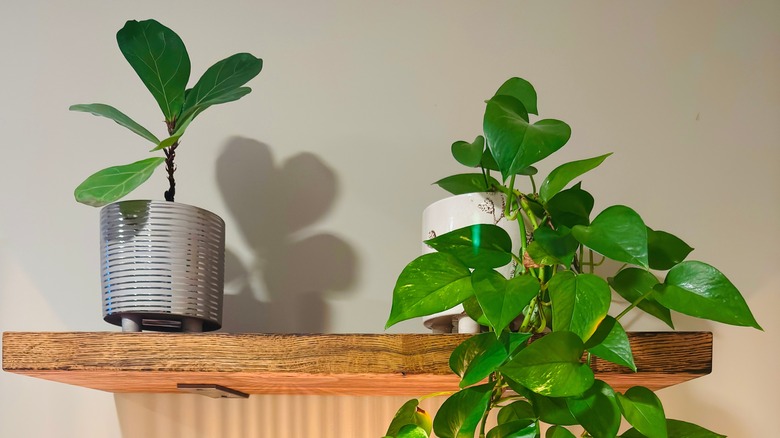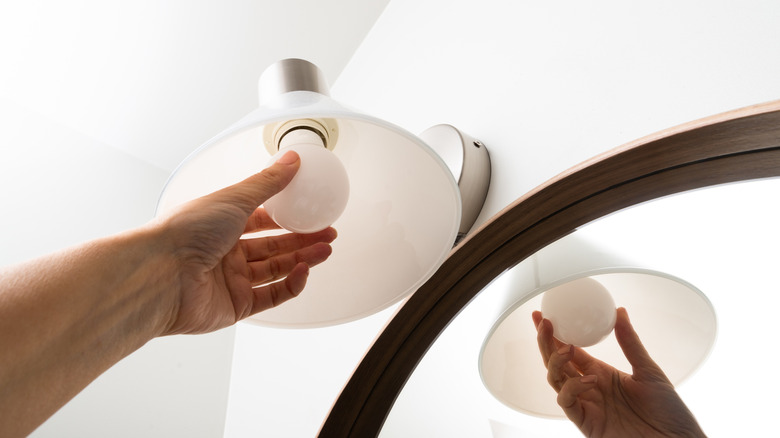How To Make A Money Plant Grow In A Windowless Bathroom
Of all the tricks for brightening up your windowless bathroom, only one will make a difference to your plants: lighting. Different plants require different levels of lighting to thrive, but they all require at least some, and without windows, artificial lighting is your only option. Luckily, indoor lighting works perfectly well for some plants, including the popular money plant.
Note that "money plant" can refer to lots of different plants, like the pilea (Pilea peperomioides) and others — but in this case, we're talking about pothos (Epipremnum aureum). Native to Southeast Asia and the western Pacific Islands, pothos are one of the most popular indoor houseplants of all because they're so easy to take care of.
A bathroom is a great setting to try growing an indoor pothos because it provides the high humidity levels that this plant prefers. And unlike some other houseplants, pothos can continue to grow and thrive even with little access to light since they grow underneath the canopies of other plants in their native environment. A windowless bathroom can work just fine for a pothos, especially if you pick the right lightbulbs.
The best bathroom lights for pothos
Pothos' ability to stay green in darker rooms has even gained it a nickname –"devil's ivy." They may not be able to actually grow in the dark, but they tolerate indoor lighting so well that it can seem like it. Anecdotally, many people have seen their pothos thrive in windowless environments, even without using special lights. But for the best results, invest in some pothos-friendly bathroom lighting.
There are several types of grow lights for indoor plants you can choose from. First, fluorescent lighting is your standard office or hospital lighting and is the most popular indoor light source for houseplants. These bulbs can get quite bright without producing a lot of heat and are ideal for plants with lower light requirements, such as pothos. Second, LED lights produce almost no heat at all and come in a wider variety of options for color, brightness, temperature, and size as compared to fluorescent lights.
Regardless of which type of light you pick, don't just buy any old bulb — look for a full-spectrum light. These provide light across wavelengths, including both red and blue, so the light resembles natural sunlight and is ideal for plant growth. Typically, full-spectrum lights are between 5000 and 6500 Kelvin. Some are specifically labeled as grow lights, but not all. There's a third option for plant lights, incandescent bulbs, but they get quite hot and don't provide even light across the spectrum, so they're not the best choice.
Other considerations
In addition to full-spectrum light, look for a lightbulb with a high enough output of 3000 lumens or more. Keep your pothos within the 1- to 2-foot range of the bulb so it can access all the light it needs, and keep the light on for up to 10 to 12 hours per day to mimic the natural daylight cycle. If you're reluctant to replace your regular bathroom lights with pothos-friendly ones or to leave them on for so many hours of the day, opt for an LED clip-on that you can dedicate to your plant pal.
Some pothos are more adaptable to low or artificial light than others. In general, pothos prefer to get bright indirect light if they can, and variegated pothos like the 'Marble Queen' or 'Tricolor' varieties require more light to thrive; with inadequate light, they may lose their variegation. The bright-leafed 'Neon' variety also needs more light to stay healthy. Instead, opt for the 'Jade' variety, which has solid, darker leaves and does especially well in low light.


